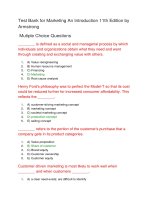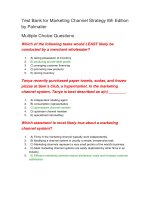Test bank for practice management for the dental team 8th edition by finkbeiner
Bạn đang xem bản rút gọn của tài liệu. Xem và tải ngay bản đầy đủ của tài liệu tại đây (30.25 KB, 3 trang )
Chapter 01: The Business of Dentistry
Test Bank
MULTIPLE CHOICE
1. Management is defined as the
a. process of providing quality care for the patient.
b. enterprise in which one is engaged to achieve a livelihood.
c. process of transmitting information from one person to another.
d. act of leading a team of persons to accomplish goals and objectives.
ANS: D
Management is the act of leading a team of persons to accomplish goals and objectives. The process of providing quality care for
the patient is the definition of service. The enterprise in which one is engaged to achieve a livelihood is the definition of business.
The process of transmitting information from one person to another is the definition of communication.
REF: Key Terms, p. 1
OBJ: 1
2. Organizational culture is defined as the sum of the organization’s
a. beliefs.
b. attitudes.
c. experiences.
d. all of the above.
ANS: D
An organizational culture comprises the beliefs, attitudes, experiences, and values of an organization.
REF: Organizational Culture, p. 4
OBJ: 1
TesttheBank
Practice
Management
leaderfor
of the
dental office.
3. The ___ is commonly
a. dentist
b. dental assistant
c. dental hygienist
d. administrative assistant
for the Dental Team 8th Edition by Finkbeiner
ANS: A
The dentist is commonly the leader in a dental practice. The dental assistant may have management responsibilities but is not
commonly a leader of the dental office. The dental hygienist may have management responsibilities but is not commonly a leader
of the dental office. The administrative assistant may have management responsibilities but is not commonly a leader of the dental
office.
REF: Leadership and Management in the Twenty-First Century, p. 8
OBJ: 7
4. Which personal trait of an effective leader provides employees with information to help them increase their productivity within the
dental office?
a. Managing chaos
b. Empowering others
c. Building a shared vision
d. Living by a set of values
ANS: B
An effective leader empowers the staff and provides employees with access to information that will help them increase their
productivity and effectiveness. Managing chaos means resolving conflict and moving staff forward to bring about desired
outcomes. Building a shared vision is working with the staff to determine how the practice vision and individual goals and
objectives meet the vision of the practice. Living by a set of values is identifying and defining the principles of ethics and
acceptable behavior and ensuring that they are carried out during routine daily practice.
REF: Empower Others, p. 4
OBJ: 8
5. Successful dentists do not take risks with their dental practice. Remaining status quo will result in success.
a. Both statements are true.
b. Both statements are false.
c. The first statement is false; the second statement is true.
d. The first statement is true; the second statement is false.
ANS: B
Both statements are false. Successful dentists know that not all risk taking is successful, but they are willing to take calculated
risks, knowing that the status quo can also result in failure.
REF: Reward Risk Taking, p. 8
OBJ: 7
Copyright © 2016 by Mosby, an imprint of Elsevier Inc.
Full file at />
1
6. All of the following are characteristics of successful risk taking except
a. doing it alone.
b. being open minded.
c. trusting your abilities.
d. overcoming the fear of mistakes.
ANS: A
Going it alone is the exception. Keys to successful risk taking include being open minded, trusting in your abilities, overcoming the
fear of mistakes, and developing support teams.
REF: Reward Risk Taking, p. 9
OBJ: 7
7. Persons from which country are categorized as linear active?
a. Italy
b. Japan
c. Finland
d. Germany
ANS: D
Germans are categorized as linear active. These are cultures that plan, schedule, organize, pursue action chains, and do one thing at
a time. Italians are categorized as multi-active. These are cultures that do many things at once, planning their priorities not
according to a time schedule but according to the relative thrill or importance that each appointment brings with it. Japanese and
Finns are categorized as reactive. These are cultures that prioritize courtesy and respect, listening quietly and calmly to their
interlocutors and reacting carefully to the other side’s proposals.
REF: Cultural Competency, p. 4
OBJ: 3
8. A worker from the Philippines is more likely to remain silent when being criticized by a superior. Silence is not usually considered
appropriate in the American workplace.
a. Both statements are true.
b. Both statements are false.
c. The first statement is false; the second statement is true.
d. The first statement is true; the second statement is false.
ANS: A
Both statements are true. The United States is referred to as a talk or verbal society with silence not usually considered appropriate
in the workplace. In the Philippines, a worker is more likely to apologize with an action such as extending a favor to the superior
who is criticizing but say nothing.
REF: Cultural Competency, p. 4
OBJ: 3
9. Which interaction is not associated with reflective listening?
a. Responding indifferently to a person’s concerns
b. Restating and clarifying what the person has said
c. Listening to the person’s concerns rather than just waiting to talk
d. Trying to understand the feelings contained in what the other is saying
ANS: A
Responding indifferently to a person’s concerns is not part of reflective listening. In reflective listening, the listener absorbs what
has been said, reflects on it, and restates or paraphrases the feeling or content of the message in a way that demonstrates
understanding and acceptance.
REF: Effective Listening. p. 11
OBJ: 8
10. The Doctor of Dental Surgery (DDS) degree is the same degree as an Oral and Maxillofacial Surgery degree. The Doctor of Dental
Medicine (DMD) is a degree granted to a dentist upon graduation from a university dental school.
a. Both statements are true.
b. Both statements are false.
c. The first statement is false; the second statement is true.
d. The first statement is true; the second statement is false.
ANS: C
The first statement is false; the second statement is true. The DDS and DMD are essentially the same degrees and are granted to
dentists upon graduation from university dental schools. An Oral and Maxillofacial Surgery degree is a dental specialty requiring
education beyond a DDS or DMD degree.
REF: General Dentistry, p. 6; Specialties of Dentistry, pp. 6-7
OBJ: 1 | 5
TRUE/FALSE
1. The traditional education of the dentist has placed great emphasis on developing the practice management skills of the dentist.
ANS: F
The traditional education of the dentist has placed great emphasis on developing a highly competent diagnostician and clinician but
has often left a noticeable void in the area of practice management.
REF: Intro, p. 2
OBJ: 2
Copyright © 2016 by Mosby, an imprint of Elsevier Inc.
Full file at />
2
2. Financial activities should take place in the clinical area of the dental office.
ANS: F
The business office should assume its rightful name because all business activities of the practice take place there, including
financial transactions, patient and staff communication, appointment management, recall, inventory, insurance management, and
records maintenance.
REF: Intro, p. 2
OBJ: 2
3. Patients rate service as the most important thing they can receive.
ANS: T
Dental treatment may be the objective for a patient; however, the dental staff must be constantly aware that when patients come to
the office to seek treatment, they are seeking the most important product, service.
REF: Dentistry as a Service Profession, pp. 2-3
OBJ: 3
4. A dental practice mission statement should state how the practice is managed and the role of staff and patients.
ANS: T
It is wise for the dentist to determine a practice mission statement that speaks to the way the practice is to be managed and the role
of the staff and its patients.
REF: Build a Shared Vision, p. 8
OBJ: 6
5. A patient’s culture greatly influences communication.
ANS: T
The dental staff must be aware of how to communicate with the difference not only in generational changes but in cultural
differences. Culture makes a great difference in communication.
Test Bank for Practice Management for the Dental Team 8th Edition by Finkbeiner
REF: Cultural Competency, p. 4
OBJ: 3
Full file at />MATCHING
Choose the definition that correlates with each term below.
a. Authoritarian leadership
b. Teams formed to solve problem
c. Fear and distrust exist in this environment
d. Feedback does not exist in this environment
e. Cross-departmental communication to achieve goals
1.
2.
3.
4.
5.
Task culture
Blame culture
Power culture
Process culture
Multidirectional culture
1.
2.
3.
4.
5.
ANS:
ANS:
ANS:
ANS:
ANS:
B
C
A
D
E
REF:
REF:
REF:
REF:
REF:
Organizational Culture, p. 5
Organizational Culture, p. 6
Organizational Culture, p. 5
Organizational Culture, p. 5
Organizational Culture, p. 6
OBJ:
OBJ:
OBJ:
OBJ:
OBJ:
4
4
4
4
4
Choose the definition that best correlates with a dental specialty.
a. Prevents and controls dental diseases and promotes dental health through
organized community efforts
b. Diagnoses, treats, and maintains the function of conditions associated with
missing or deficient teeth and oral and maxillofacial tissues
c. Encompasses the prevention, diagnosis, and treatment of diseases of the
supporting and surrounding tissues of the teeth
d. Includes the diagnosis, prevention, interception, and correction of all forms of
malocclusion
e. Provides both oral healthcare of children from infancy through adolescence,
including care for patients beyond the age of adolescence with special healthcare
needs
6.
7.
8.
9.
10.
Periodontics
Prosthodontics
Pediatric dentistry
Dental public health
Orthodontics and dentofacial orthopedics
6.
7.
8.
9.
10.
ANS:
ANS:
ANS:
ANS:
ANS:
C
B
E
A
D
REF:
REF:
REF:
REF:
REF:
Specialties of Dentistry, p. 7
Specialties of Dentistry, p. 7
Specialties of Dentistry, p. 7
Specialties of Dentistry, p. 7
Specialties of Dentistry, p. 7
OBJ:
OBJ:
OBJ:
OBJ:
OBJ:
Copyright © 2016 by Mosby, an imprint of Elsevier Inc.
Full file at />
5
5
5
5
5
3









